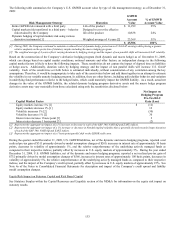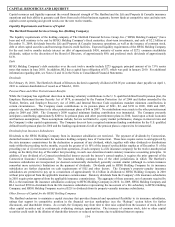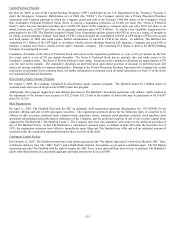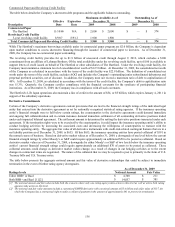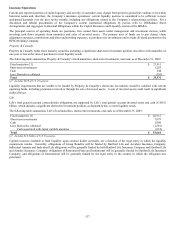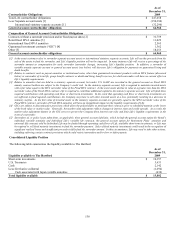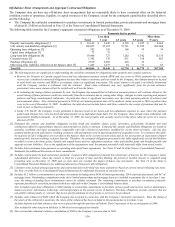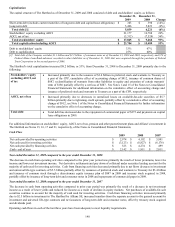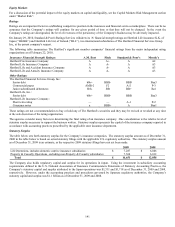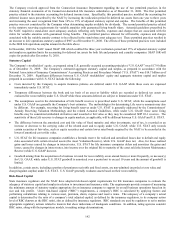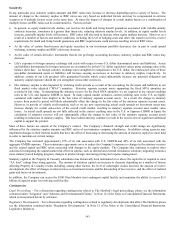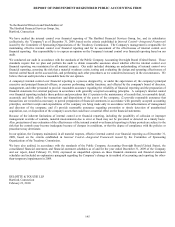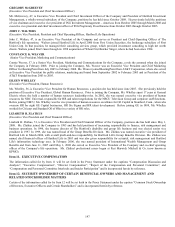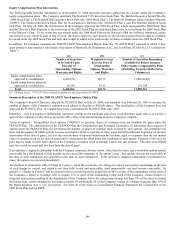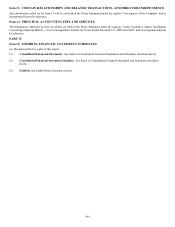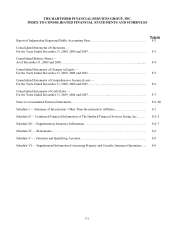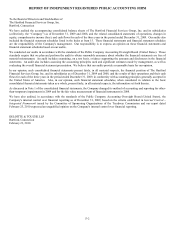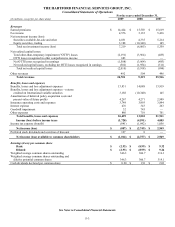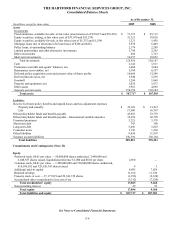The Hartford 2009 Annual Report Download - page 143
Download and view the complete annual report
Please find page 143 of the 2009 The Hartford annual report below. You can navigate through the pages in the report by either clicking on the pages listed below, or by using the keyword search tool below to find specific information within the annual report. 143
Sensitivity
In any particular year, statutory surplus amounts and RBC ratios may increase or decrease depending upon a variety of factors. The
amount of change in the statutory surplus or RBC ratios can vary based on individual factors and may be compounded in extreme
scenarios or if multiple factors occur at the same time. At times the impact of changes in certain market factors or a combination of
multiple factors on RBC ratios can be counterintuitive. Factors include:
• In general, as equity market levels decline, our reserves for death and living benefit guarantees associated with variable annuity
contracts increases, sometimes at a greater than linear rate, reducing statutory surplus levels. In addition, as equity market levels
increase, generally surplus levels will increase. RBC ratios will also tend to increase when equity markets increase. However, as a
result of a number of factors and market conditions, including the level of hedging costs and other risk transfer activities, reserve
requirements for death and living benefit guarantees and RBC requirements could increase resulting in lower RBC ratios.
• As the value of certain fixed-income and equity securities in our investment portfolio decreases, due in part to credit spread
widening, statutory surplus and RBC ratios may decrease.
• As the value of certain derivative instruments that do not get hedge accounting decreases, statutory surplus and RBC ratios may
decrease.
• Life’ s exposure to foreign currency exchange risk exists with respect to non-U.S. dollar denominated assets and liabilities. Assets
and liabilities denominated in foreign currencies are accounted for at their U.S. dollar equivalent values using exchange rates at the
balance sheet date. As foreign currency exchange rates strengthen in comparison to the U.S. dollar, the remeasured value of those
non-dollar denominated assets or liabilities will increase causing an increase or decrease to statutory surplus, respectively. In
addition, certain of our Life products offer guaranteed benefits which could substantially increase our potential obligation and
statutory capital exposure should the yen strengthen versus other currencies.
• Our statutory surplus is also impacted by widening credit spreads as a result of the accounting for the assets and liabilities in our
fixed market value adjusted (“MVA”) annuities. Statutory separate account assets supporting the fixed MVA annuities are
recorded at fair value. In determining the statutory reserve for the fixed MVA annuities, we are required to use current crediting
rates in the U.S. and Japanese LIBOR in Japan. In many capital market scenarios, current crediting rates in the U.S. are highly
correlated with market rates implicit in the fair value of statutory separate account assets. As a result, the change in statutory
reserve from period to period will likely substantially offset the change in the fair value of the statutory separate account assets.
However, in periods of volatile credit markets, such as we are now experiencing, actual credit spreads on investment assets may
increase sharply for certain sub-sectors of the overall credit market, resulting in statutory separate account asset market value
losses. As actual credit spreads are not fully reflected in the current crediting rates in the U.S. or Japanese LIBOR in Japan, the
calculation of statutory reserves will not substantially offset the change in fair value of the statutory separate account assets
resulting in reductions in statutory surplus. This has resulted and may continue to result in the need to devote significant additional
capital to support the product.
Most of these factors are outside of the Company’ s control. The Company’ s financial strength and credit ratings are significantly
influenced by the statutory surplus amounts and RBC ratios of our insurance company subsidiaries. In addition, rating agencies may
implement changes to their internal models that have the effect of increasing or decreasing the amount of statutory capital we must hold
in order to maintain our current ratings.
The Company has reinsured approximately 25% of its risk associated with U.S. GMWB and 44% of its risk associated with the
aggregate GMDB exposure. These reinsurance agreements serve to reduce the Company’ s exposure to changes in the statutory reserves
and the related capital and RBC ratios associated with changes in the equity markets. The Company also continues to explore other
solutions for mitigating the capital market risk effect on surplus, such as internal and external reinsurance solutions, migrating towards a
more statutory based hedging program, changes in product design, increasing pricing and expense management.
Statutory capital at the Property & Casualty subsidiaries has historically been maintained at or above the capital level required to meet
“AA level” ratings from rating agencies. The amount of statutory capital can increase or decrease depending on a number of factors
affecting Property & Casualty results including, among other factors, the level of catastrophe claims incurred, the amount of reserve
development, the effect of changes in interest rates on investment income and the discounting of loss reserves, and the effect of realized
gains and losses on investments.
In addition, the Company can access the $500 Glen Meadow trust contingent capital facility and maintains the ability to access $1.9
billion of capacity under its revolving credit facility.
Contingencies
Legal Proceedings – For a discussion regarding contingencies related to The Hartford’ s legal proceedings, please see the information
contained under “Litigation” and “Asbestos and Environmental Claims,” in Note 12 of the Notes to Consolidated Financial Statements,
which is incorporated herein by reference.
Regulatory Developments – For a discussion regarding contingencies related to regulatory developments that affect The Hartford, please
see the information contained under “Regulatory Developments” in Note 12 of the Notes to the Consolidated Financial Statements.
Legislative Initiatives.


